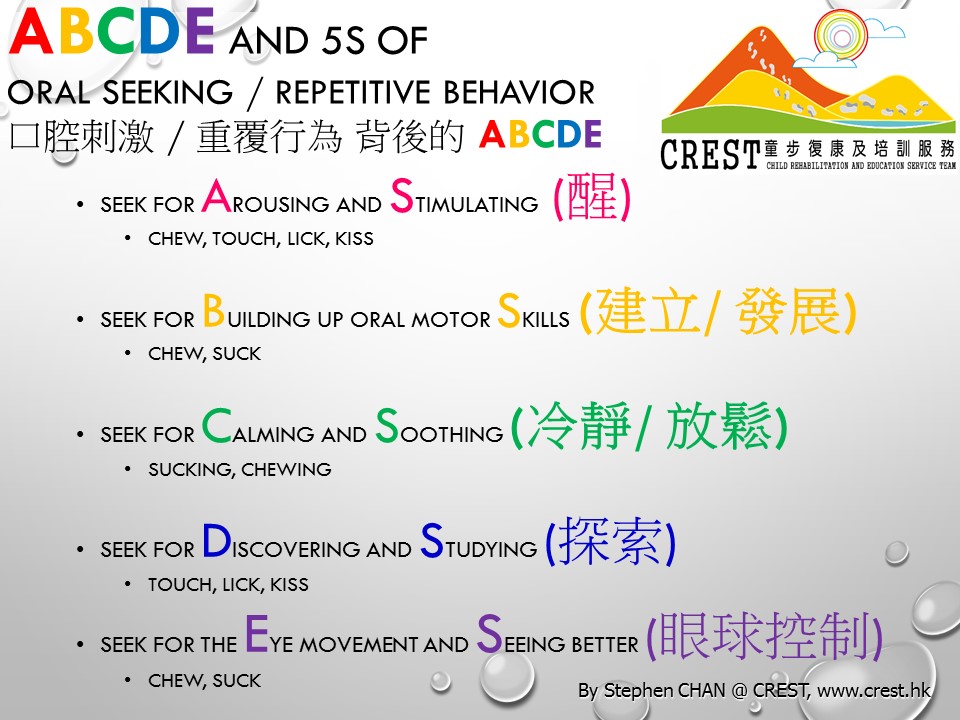尋求刺激行為背後的 ABCDE : 口腔刺激
The A.B.C.D.E behind seeking behavior : Oral Seeker
[English version at the bottom following the Chinese one]
尋求刺激行為背後的 ABCDE : 口腔刺激
The A.B.C.D.E behind seeking behaviors: Oral Seeker
[English version at the bottom following the Chinese one]
(撰文: CREST 一級職業治療師 陳子文先生)
嘗試明白原因對決定如何介入很有幫助。
我們綜合我們的觀察及神經科學的理論, 提出以下ABCDE 的方法來分析尋求刺激, 特別是口腔刺激的行為。
A. for Arousing and Stimulating – 尋求刺激讓自己更 “醒”。他們多會尋求變化, 新奇, 有趣的刺激。因應個別孩子的感覺特質便會選擇最能令他們 “醒神” 的刺激。例如: 當警醒度下降時,會搖頭 / 擺身 / 咬物件/ 製造聲音來警醒自己。
B. for Building up Skills – 尋求刺激來配合發展上的需要 。他們因應發展上的需要來尋找刺激,如:行石壆練平衡; 嚼物件練口肌。
C. for Calming and Soothing – 尋求刺激來冷靜自己, 如啜手指, 嚼物件, 用力推拉, 索求擁抱。
D. for Discovering and Studying – 尋求刺激為了探索 。如視覺或/及手功能較差的學生會以口代眼, 以口代手來探索。
E. for Eye movement and Seeing – 尋求刺激不是為了刺激, 而是透過口面肌肉的力度來使眼球肌肉得以穩定地操作, 控制, 提昇視覺專注的能力 。
The A.B.C.D.E behind seeking behaviors: Oral Seeker
An Introductory Article on
“Understanding the ABCDE behind seeking behaviors” – oral seeking is highlighted in the picture.
(by Occupatioal Therapist from crest.hk, Stephen Chan)
A. for Arousing and Stimulating – Stimulation makes people alert and aroused. We may seek for vigorous movements, crunchy snacks, or washing face with cool water to arouse ourselves. Seeking behaviors may also be due to the need to get aroused for extra dopamine and adrenaline hit!
B. for Building up Skills – Repeating an activity or action can sharpen the skills of doing that. Our nervous system has the tendency to excel itself. Children like to walk on edge of a path when developing their balance, They chew objects when they are developing their jaw strength.
C. for Calming and Soothing – Some of the repetitive behaviors are repeated by the child because of its soothing nature. For example, kids seek for thumb sucking, deep pressure because of their calming nature.
D. for Discovering and Studying – Kids who have weaknesses in one sense may seek for input from another senses to facilitate them to discover, study, explore and learn from their experience.. E.g. kids with visual and fine motor problems may tend to use their mouth or forceful proprioceptive input to discover, and study the environment and toys in hand.
E. for Eye movement and Seeing – orofacial muscles work as soft tissue joints, they function as stability provided to help each other. E.g. chewing objects can be an adaptive response to help eye muscles move better and allow better visual focus.
Understanding the intention and purpose behind each behavior is important when we look at different “inappropriate seeking” behaviors, because those behaviors could actually be an adaptive response serving particular purpose.

